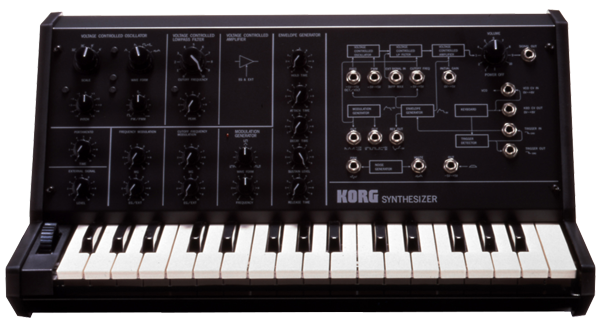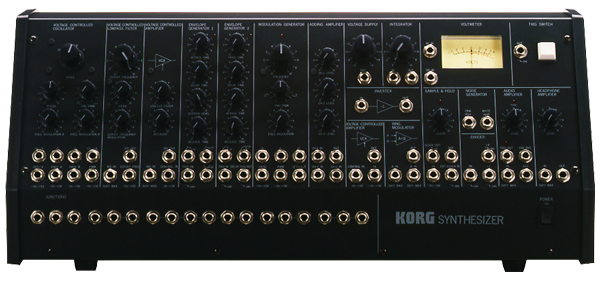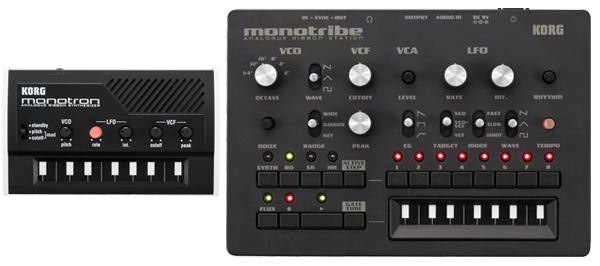
SoundCloud

MS-20 mini
MONOPHONIC SYNTHESIZER
Soporte
Saber mas
Sitios relacionados
Productos relacionados
Accesorios
Noticias relacionadas
- 2017.01.12
- KORG announces new products at Winter NAMM 2017!
- 2014.06.17
- Producer Steve Levine shows the MS-20 mini used with the VOX Trike Fuzz and Double Deca Delay effect pedals.
- 2014.06.11
- Korg MS-20 Mini High Five by yours truly Mr. Formidoni
- 2014.05.12
- Adding a Band-Pass Filter to the Korg MS-20 Mini
- 2014.04.01
- MS-20 Mini wins KEY BUY award
The History of the MS-20 Monophonic Synthesizer
The Korg MS-20 was released in 1978 following the concept of "a wall on your desktop." Although it was a monophonic synthesizer, it was developed with stringent attention to cost management in order to create an instrument that was affordable to as many people as possible, while providing the free patching flexibility of a modular synthesizer. This allowed it to immediately capture the hearts of not only young synthesizer aficionados worldwide, but also those of professional musicians; catapulting the MS-20 into the limelight. In its various forms, the MS-20 has been appreciated by a total of 300,000 people* since its introduction. Now, after 35 years, it has been resurrected intact as the MS-20 mini. In commemoration, we would like to introduce the history of the MS-20 and describe its success, while also taking a look at the MS series and other products.
*Total number of sales for all related products
PS-3100 / PS-3200 / PS-3300 (introduced in 1977 / 1978 / 1977)

PS-3100

PS-3200

PS-3300
The prehistory of the MS-20: it started with the Polysynth
The Polysynth series - PS series - boasted amazing specs for the time period. The PS-3100 – with its integrated keyboard - was completely polyphonic; offering a VCO, VCF, VCA, and EG for each of its keys making it 48-note polyphonic. It could also be flexibly patched and freely adjusted to tunings other than equal temperament. The PS-3200 separated the keyboard unit from the sound generator; it contained two VCOs and programmable memory that let users store up to 16 different sounds. Last but not least, the PS-3300 - the flagship model of the PS series - was a tour-de-force whose cabinet contained three PS-3100 units (that’s 144 mono synths)! It was a favorite of Keith Emerson and Jean Michel Jarre.
MS-20 (introduced 1978)

MS-20
The big hit - "A wall on your desktop"
One of the development themes for the PS-3100 that went on sale the preceding year was how to pack “big synth” circuitry into a limited space. It had been a struggle to make the circuitry as compact as possible in order to avoid lowering the specs. The circuitry developed for the comparably behemoth PS-3100 was utilized in the MS-20 to create a monophonic synthesizer which had two sets of VCO, VCF, VCA, and EG, as well as a patch panel and a module for external audio input and CV conversion. In keeping with its philosophy of being a synthesizer with as broad an appeal as possible, it was designed under rigorous cost management, and the dimensions of its sheet metal body were also chosen for reasons of economy. In particular, the powerful sound of its filter became a distinctive characteristic of the MS-20, making it representative of "the Korg sound."
MS-10 (introduced 1978)

MS-10
A basic model that contributed to the spread of synthesizers
The MS-10 was the most compact model of the MS series; a monophonic synthesizer with a single set of VCO, VCF, VCA, and EG controls. Although simple, it also provided a patch panel that supported a diverse range of sound-creating methods. While the MS-20 had 37 keys, the MS-10 had 32. In spite of its single VCO, it could generate distinctively fat and robust sounds. On top of this, its price tag matched its diminutive size. At 53,500 yen (about $300 U.S. at the time), it was incredibly accessible; helping to popularize the synthesizers in general. Many young players of that time chose MS-10 as their first synth. It has since been a favorite of The Orb, Chemical Brothers, Juan Atkins, Underworld and numerous others.
MS-50 (introduced 1979)

MS-50
The fully patchable top model of the series
Introduced as an expansion module for the MS-10/20, the MS-50 is a rare model within the MS series. Based on MS-20, it had no keyboard, but added internal circuits such as a divider and integrator not found on the MS-10/20, which supported even more complex ways of creating sound. The voltmeter on the upper right-hand side of the panel captured the hearts of many synth players. Of course, it could also be played on its own by using CV/Gate signals. While the MS-10/20 provided a basic signal route that was internally connected, and therefore could be played without any patching, the MS-50 used a fully patch-reliant design. By using the MS-50 in conjunction with an MS-10/20 or the SQ-10 described below, it was possible to construct a larger-scale modular system.
MS-01 / MS-02 / MS-03 / MS-04 (introduced 1979)

MS-01 / MS-02

MS-03 / MS-04
The other entries in the MS series: specialized add-ons
To help users connect their various MS series products, four function-specific modules were offered shortly after the first products were introduced. These provided additional functionality for live performance or studio use, and could be matched with various synthesizers to expand the potential of the MS series to an even higher level. The MS-01 foot controller let users use their feet to regulate a voltage signal that controlled each synth module. The MS-02 was a convenient interface that converted the CV/Gate signals, which at the time did not share a consistent standard between manufacturers. The MS-03 signal processor converted an audio signal into CV/gate signals, allowing users to employ external instruments audio sources, such as a guitar or vocal, to trigger a synth. Lastly, the MS-04 modulation pedal contained an LFO and let you use a pedal to control the VCO or VCF of the MS series unit to which it was connected.
SQ-10 / VC-10 (introduced 1978)

SQ-10

VC-10
Expansion products
The SQ-10 went on sale at the same time as the MS-20. It was a 12-step x 3-channel analog sequencer that had a voltage controlled clock generator which let users continuously vary the time duration between steps, as well as an independent trigger output for each step; allowing users to program a wide variety of sequences. Users could utilize each step as a sound memory, and there were some who took advantage of its flexible connectivity by using it as a lighting controller. The VC-10 was the first vocoder in the world to have a built-in keyboard, and it drew a great deal of attention as a vocoder that could be used live. Its distinctive sound was loved by numerous keyboardists including Joe Zawinul. The design, which allowed a dedicated mic to be attached to the unit, was later reused in the microKORG as well as in numerous products overseas.
MS2000 (introduced 2000)

MS2000B
Combining vintage technologies for a new era of MS
More than twenty years after the MS-20, the MS2000 analog modeling sound module made its appearance. Although its voicing parameters and sound were developed as "a new synthesizer for the new millennium," it provided virtual patch functionality based on the patch panel of the MS-20, a modulation sequencer based on the SQ-10, and an internal vocoder based on the VC-10. All these technologies were built into a single instrument designed for present-day tastes. The rosewood side panels and the steeply slanted panel design also made a bold statement. MS2000 was the foundational model behind subsequent Korg analog modeling synthesizers such as the microKORG and the RADIAS.
KORG Legacy Collection / MS-20 plugin with MS-20 MIDI controller (introduced 2004)

MS-20 a software synthesizer

MS-20 Controller

OASYS

KRONOS
The MS-20 reborn as a software synthesizer
The sound engine of the MS-20 was comprised of a unique circuit design that had been simplified to the utmost degree. For each of its functions, a single transistor played an extremely important role, and this was a decisive factor in determining the MS sound. The MS-20 software project, which started as a kind of skunkworks within the Korg development department, perfectly simulated the characteristics of every single one of these electronic components. Instead of tracing the characteristics of the sound, which had been typical of software synthesizers up to that point, this project reproduced each circuit itself in software. This component-by-component modeling method was appropriated named “Component Modeling Technology,” or “CMT” for short. It also used cutting-edge tools to render the graphics to a startlingly faithful degree of precision. Together with the MS-20 controller, which was a faithful reproduction of the original MS-20 at 84% of its original size, the MS-20 plugin along with the rest of the Legacy Collection continues to be loved by artists around the world.
In 2006, Korg released the LAC-1: Legacy Analog Collection as an optional "Expansion Instrument" for the Open Architecture Synthesis Studio "OASYS", which was released in 2005. The MS-20EX was implemented as standard feature for the revolutionary KRONOS Music Workstation in 2011, and also in KRONOS X, in 2012. The now familiar sounds of the "MS-20" have been ubiquitous in popular music for the past 35 years, as well as throughout the history of Korg’s most legendary and influential products.
monotron / monotron DUO / monotron DELAY / monotribe (introduced 2010 and 2011)

monotron / monotribe
New sounds only possible with analog
The monotron/monotribe series were developed from the concept of an analog synthesizer that would fit in the palm of your hand. With a VCF that was capable of self-oscillation while using the same circuit as the MS-10/20 to generate powerful sounds, the monotron provided a single set of VCO, VCF, and LFO controls, while the monotron DUO provided two VCO units, and the monotron DELAY featured an internal delay unit. Development benefited from advice that was provided by the developers of the MS-20, making the sound even more robust. Based on this monotron, the sound engine was further enhanced, and with the addition of a step sequencer and analog drums inherited from the ELECTRIBE series, it was released as the monotribe; ushering in a new generation of analog devices where "the operations themselves are the performance." The sync functionality was also analog, allowing audio signals to be used. It goes without saying that the filter also used the same circuit as the MS-10/20.
KORG iMS-20 for iPad (introduced 2010)

KORG iMS-20 for iPad
Transforming your iPad into an analog synth studio
The iMS-20 iPad app developed in cooperation with the DETUNE Corporation used Korg's proprietary "CMT" sound engine technology not only to perfectly reproduce the sound of the MS-20 but to also provide an analog sequencer based on the SQ-10 and a six-part drum machine, making it a full-fledged music production environment that could be used by professionals. Its KAOSS PAD function allowed it to be played and controlled intuitively, and integration with the "SoundCloud" music distribution and sharing site meant that the iMS-20 opened up a new style of music making to everyone. In addition to reproducing the patching of the MS-20, it also allowed "banana patching" that made it possible to connect one output to multiple inputs - one of the many ideas that were possible only when implemented in digital form.







